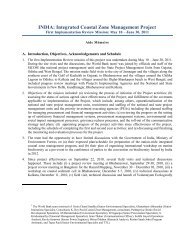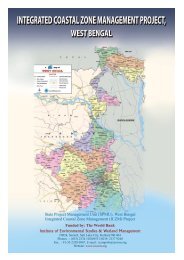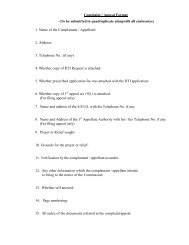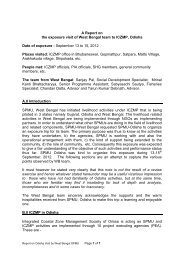Cyclone and Storm Surge - Iczmpwb.org
Cyclone and Storm Surge - Iczmpwb.org
Cyclone and Storm Surge - Iczmpwb.org
You also want an ePaper? Increase the reach of your titles
YUMPU automatically turns print PDFs into web optimized ePapers that Google loves.
2.22<br />
formed does not pose so much of an acute problem.<br />
Water flows into the Sundarbans during rising tide as long as the water levels in the areas accessible<br />
for the incoming tides, to wit: the rivers <strong>and</strong> the unprotected l<strong>and</strong>s are lower than sea level. Like-wise<br />
water flows to the sea as long as the water in the system of waterways <strong>and</strong> unprotected areas is<br />
higher than sea level.<br />
The volume of water that flows into the estuary of a river <strong>and</strong> on the inundated l<strong>and</strong> is that held<br />
between high water <strong>and</strong> low water levels. The volume of this layer is usually indicated as the "live<br />
storage" of the system. The "dead storage" is the volume of water that remains in the rivers <strong>and</strong><br />
creeks at the end of ebb period.<br />
When water starts flowing in, the volume of water indicated as the dead storage is pushed inwards.<br />
This water will fill in the live storage situated at the l<strong>and</strong> side of the estuary. Fresher water from the<br />
sea mixes with older water from the dead storage, but this process takes only place in a limited zone.<br />
As a result of which, the water at the far end of the system is replaced only very slowly by new water<br />
from the sea. A large portion of water moves oscillates within the rivers, without leaving the estuary.<br />
The larger the dead storage is in comparison with the live storage, the larger the volume that remains<br />
in the system for series of tides. This is of importance for the process of erosion <strong>and</strong> sedimentation in<br />
the Sundarban.<br />
The shape of the volumes of the creeks, channels <strong>and</strong> the tidal flats of the Sundarbans, providing the<br />
live <strong>and</strong> the dead storage is very irregular. These may be thought of as a series of reservoir sections<br />
connected to each other through channels. These channels, of course, also contribute to the storage.<br />
The larger the live storage of any section to be filled through one or more canals, the more water is<br />
flowing in <strong>and</strong> out through these canals with each tide.<br />
When the live storage is reduced because of sedimentation or because of human interventions like<br />
blocking creeks or building embankments around areas presently inundated, less water needs to flow<br />
to <strong>and</strong> fro in the river sections feeding this part of the reservoir. When the dead storage of a river is<br />
reduced by sedimentation, the wetted area will also be reduced <strong>and</strong> consequently the current in<br />
these rivers needs to increase to allow the same volume of water to pass. In general it can be stated<br />
that a reduction of the live storage will reduce the incoming <strong>and</strong> outgoing volumes <strong>and</strong> that reduction<br />
of the dead storage increases the velocities.
















